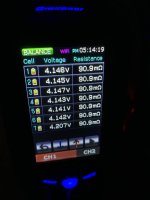I have a max amps 48v 13s 44Ah 40C pack.
After 40 min or so of aggressive riding, I notice the pack does get hot, around 109F degrees on the exterior. Not sure the temp deep within the pack. Peak amp draw is around 300A but nothing much higher as shown on my ammeter I have connected. The power cable get very warm during high current use as well.
Is 109F measured on the outer surface of the pack too hot to continue to use? I thought 300A peak and 100A continuous is well within the 40C rating of my pack.
I also notice a total pack voltage drop of 8v from 50v to 42v during the peak current draws.
After 40 min or so of aggressive riding, I notice the pack does get hot, around 109F degrees on the exterior. Not sure the temp deep within the pack. Peak amp draw is around 300A but nothing much higher as shown on my ammeter I have connected. The power cable get very warm during high current use as well.
Is 109F measured on the outer surface of the pack too hot to continue to use? I thought 300A peak and 100A continuous is well within the 40C rating of my pack.
I also notice a total pack voltage drop of 8v from 50v to 42v during the peak current draws.





